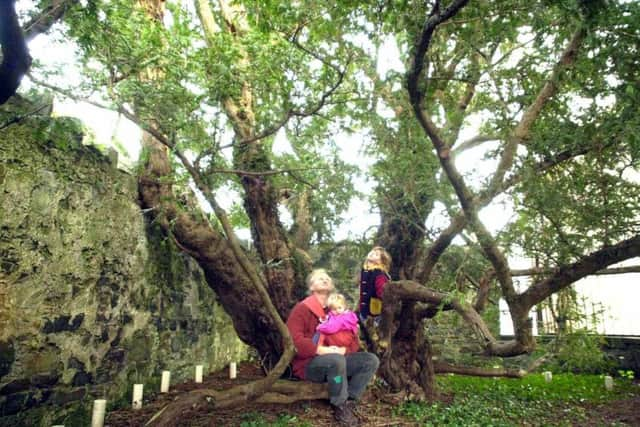Threat to ancient Scots yew, UK’s oldest tree, as tourists rip off branches for souvenirs
This article contains affiliate links. We may earn a small commission on items purchased through this article, but that does not affect our editorial judgement.
The Fortingall Yew in Perthshire is thought to be between 3,000 - 5,000 years old - but has a life span now of just half a century, campaigners say.
The yew tree, which is the oldest in the UK and stands tall inside the Fortingall Churchyard in Perthshire, has been left in increasingly bad health because of tourists.
Advertisement
Hide AdAdvertisement
Hide AdThey are chopping the branches off to keep for themselves, according to reports.
Despite now being surrounded by a cage in the kirkyard, tourists visiting Fortingall have allegedly been taking cuttings from the ancient yew.
Catherine Lloyd, co-ordinator of the Tayside Biodiversity Community Partnership, said the tree has become stressed.


She said: “They are attacking this poor tree, it’s stressed, and whether that’s the reason this poor tree is not doing very well at the moment, we don’t know.”
Neil Hooper, the tree warden for Fortingall, said they can’t tell how many visitors have attacked the tree, but “certainly some needles, twigs, even bits of branches have been torn off”.
He said the more common problem came from visitors climbing into the enclosure, via a listed wall, to tie beads and ribbons to the tree’s branches.
Mr Hooper said: “Recently the metal plaque put up by the Tree Council has been forced down and twisted flat face down, which must have taken considerable force, also by someone climbing into the enclosure.”
Now, in a bid to keep the original specimen alive, seedlings from the yew will be planted at various kirkyards in Perthshire and Angus, as well at the Royal Botanic Garden Edinburgh.
Advertisement
Hide AdAdvertisement
Hide AdCatherine said: “The history that one tree has seen, it’s gobsmacking.
“I would love to look back into time.
“You look at it and think it’s been there for at least 3,000 years, 1,000 years before the Romans came across Scotland.
“But we know so little about it.”
The Church Yew Tree project is a 10-year programme working in partnership with the Royal Botanic Garden Edinburgh.
The Botanic Gardens have their own yew tree hedge, which originates from cuttings from the ancient Fortingall Yew, and this will be used to grow on between 30 to 50 new saplings.
By 2020 the project aims to have identified more than 20 churchyards, which will accept the saplings for planting.
The importance of preserving the ancient tree has become even more paramount in recent years, as it’s “not doing that well at the moment”.
Due to its poor health, Catherine said one day the ancient yew will “keel over” and it could happen in “50 or 300 years”.
She said: “But if we’ve got its progeny, we’ve got its clones growing elsewhere, then the DNA will be looked after and safeguarded, and we will have more important yew trees.”
Advertisement
Hide AdAdvertisement
Hide AdThe famous tree is now being used to help plant the next generation of yews across east Scotland.
Saplings are being grown for a new project to provide churchyards across Perthshire and Angus with their own yews, grown directly from cuttings from the ancient tree.
Working in partnership with eco-congregation Scotland, the Tayside Biodiversity Community Partnership planted the first tree at Megginch Castle, near Errol, this month.
Though this tree was a sapling from the Fortingall kirkyard itself, it is unknown if it was related to the ancient yew.
Catherine said: “It might not be from the Fortingall Yew, this is why we’ve got to be careful.
“We got terribly excited when we first found out about the sapling.”
The true origin of this tree cannot be determined without a “DNA test”, according to Catherine.
She added: “We’re calling it a Fortingall kirkyard Yew because we can’t say for certain unless we have DNA that it is actually part of that yew tree.
“We need something like £1,500 to actually get DNA.
Advertisement
Hide AdAdvertisement
Hide Ad“It is possible to go ahead with that, but to be quite honest that’s not number one priority.
“We want to work with eco-congregations and grow on saplings from the original Fortingall tree.”
The history surrounding Scotland’s oldest trees is as contested as its age.
Some have suggested it has a strong connection with Christianity, as the birthplace of Pontius Pilate - who is remembered as the judge who ordered the crucifixion of Jesus Christ.
However, some historians have said the legend was an elaborate hoax by Sir Donald Currie, a shipping magnate who bought the Glenlyon Estate, where the tree is located, in 1885.
Mr Currie was known to be friends with now-famous writers such as Rudyard Kipling and Lord Tennyson, and it’s rumoured he may have invented the tale with his literary friends.
Others, who believe it is much older, suggest it has pagan roots.
